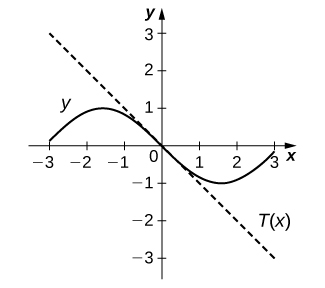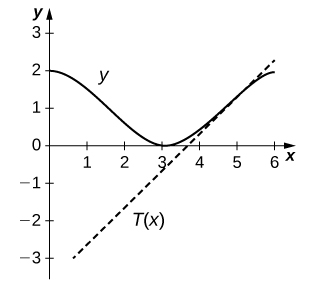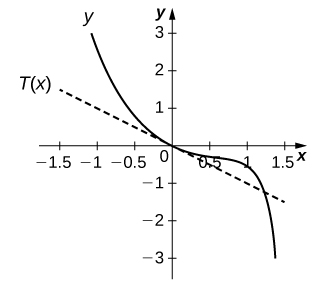3.5E: Trig Derivatives Exercises
( \newcommand{\kernel}{\mathrm{null}\,}\)
3.5: Derivatives of Trigonometric Functions
Exercise:
For the following exercises, find dydx for the given functions.
175) y=x2−secx+1
- Answer:
- dydx=2x−secxtanx
176) y=3cscx+5x
177) y=x2cotx
- Answer:
- dydx=2xcotx−x2csc2x
178) y=x−x3sinx
179) y=secxx
- Answer:
- dydx=xsecxtanx−secxx2
180) y=sinxtanx
181) y=(x+cosx)(1−sinx)
- Answer:
- dydx=(1−sinx)(1−sinx)−cosx(x+cosx)
182) y=tanx1−secx
183) y=1−cotx1+cotx
- Answer:
- dydx=2csc2x(1+cotx)2
184) y=cosx(1+cscx)
For the following exercises, find the equation of the tangent line to each of the given functions at the indicated values of x. Then use a calculator to graph both the function and the tangent line to ensure the equation for the tangent line is correct.
185) [T]f(x)=−sinx,x=0
- Answer:
-
y=−x

186) [T]f(x)=cscx,x=π2
187) [T]f(x)=1+cosx,x=3π2
- Answer:
-
y=x+2−3π2

188) [T]f(x)=secx,x=π4
189) [T]f(x)=x2−tanx=0
- Answer:
-
y=−x

190) [T]f(x)=5cotxx=π4
For the following exercises, find d2ydx2 for the given functions.
191) y=xsinx−cosx
- Answer:
- 3cosx−xsinx
192) y=sinxcosx
193) y=x−12sinx
- Answer:
- 12sinx
194) y=1x+tanx
195) y=2cscx
- Answer:
- csc(x)(3csc2(x)−1+cot2(x))
196) y=sec2x
197) Find all x values on the graph of f(x)=−3sinxcosx where the tangent line is horizontal.
- Answer:
- (2n+1)π4,where n is an integer
198) Find all x values on the graph of f(x)=x−2cosx for 0<x<2π where the tangent line has slope 2.
199) Let f(x)=cotx. Determine the points on the graph of f for 0<x<2π where the tangent line(s) is (are) parallel to the line y=−2x.
- Answer:
- (π4,1),(3π4,−1)
200) [T] A mass on a spring bounces up and down in simple harmonic motion, modeled by the function s(t)=−6cost where s is measured in inches and t is measured in seconds. Find the rate at which the spring is oscillating at t=5 s.
201) Let the position of a swinging pendulum in simple harmonic motion be given by s(t)=acost+bsint. Find the constants a and b such that when the velocity is 3 cm/s, s=0 and t=0.
- Answer:
- a=0,b=3
202) After a diver jumps off a diving board, the edge of the board oscillates with position given by s(t)=−5cost cm at tseconds after the jump.
a. Sketch one period of the position function for t≥0.
b. Find the velocity function.
c. Sketch one period of the velocity function for t≥0.
d. Determine the times when the velocity is 0 over one period.
e. Find the acceleration function.
f. Sketch one period of the acceleration function for t≥0.
203) The number of hamburgers sold at a fast-food restaurant in Pasadena, California, is given by y=10+5sinx where y is the number of hamburgers sold and x represents the number of hours after the restaurant opened at 11 a.m. until 11 p.m., when the store closes. Find y′ and determine the intervals where the number of burgers being sold is increasing.
- Answer:
- y′=5cos(x), increasing on (0,π2),(3π2,5π2), and (7π2,12)
204) [T] The amount of rainfall per month in Phoenix, Arizona, can be approximated by y(t)=0.5+0.3cost, where t is months since January. Find y′and use a calculator to determine the intervals where the amount of rain falling is decreasing.
For the following exercises, use the quotient rule to derive the given equations.
205) ddx(cotx)=−csc2x
206) ddx(secx)=secxtanx
207) ddx(cscx)=−cscxcotx
208) Use the definition of derivative and the identity cos(x+h)=cosxcosh−sinxsinh
to prove that d(cosx)dx=−sinx.
For the following exercises, find the requested higher-order derivative for the given functions.
209) d3ydx3 of y=3cosx
- Answer:
- 3sinx
210) d2ydx2 of y=3sinx+x2cosx
211) d4ydx4 of y=5cosx
- Answer:
- 5cosx
212) d2ydx2 of y=secx+cotx
213) d3ydx3 of y=x10−secx
- Answer:
- 720x7−5tan(x)sec3(x)−tan3(x)sec(x)
ADD IN J214 - J217

